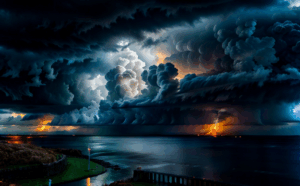Residents across Perth and Kinross are bracing for significant disruption as Storm Floris sweeps across the region, bringing with it unseasonably powerful winds. The Met Office has issued both yellow and amber weather warnings for wind, signalling severe conditions that could pose a danger to life, particularly due to large waves and flying debris.
The amber warning, in effect from 10 am until 11 pm on Monday, highlights the most critical period, with gusts anticipated to reach speeds of up to 90 miles per hour in exposed areas. Even prior to the amber warning’s full activation, gusts of 59mph were recorded in the Glenshee area, bordering Perthshire, underscoring the immediate threat posed by the storm. Extensive Travel Chaos Expected
Commuters and travellers attempting to navigate the Perth and Kinross area and beyond face substantial challenges. Rail services, a vital link for many, are severely impacted. LNER has announced the cancellation of all trains north of Newcastle, advising customers against travel across northern England and Scotland entirely. This directly affects long-distance journeys that typically pass through or originate from Perth.
Adding to the rail woes, Network Rail and ScotRail have confirmed that all train services operating north of Fife and Perth are cancelled from noon on Monday, a measure taken due to safety concerns. Other routes will operate on a reduced timetable with trains limited to a maximum speed of 50mph from 9 am. This drastic action will inevitably lead to considerable delays and cancellations for journeys connecting Perth to Dundee, Aberdeen, Inverness, and the popular Dunblane to Perth line. The knock-on effect of these cancellations could also extend into Tuesday morning, pending an assessment of track conditions and potential damage.
Road users are also facing precarious conditions and significant restrictions. The Tay Road Bridge, a key artery for travel to and from Perth and Kinross, has been closed to double-decker buses and is operating under a 30mph speed restriction, with further closures anticipated. Similarly, the Forth Road Bridge, an important route connecting Fife and Edinburgh, has also restricted access for double-decker buses. These bridge closures have a cascading effect, diverting traffic and increasing journey times for anyone travelling through the broader Tayside and Central Scotland areas.
Air travel is not immune to Floris’s wrath either. At Dundee Airport, several flights have been cancelled, including both inbound services from Heathrow (11:45 am) and Kirkwall (3:15 pm), as well as outbound flights to Heathrow (6:55 am) and Kirkwall (12:15 pm). This will undoubtedly disrupt air travel plans for residents in Perth and Kinross who utilise Dundee Airport for their connections. Local Attractions and Services Affected
Beyond the major transport networks, local amenities and services around Perthshire and neighbouring Stirling are also feeling the storm’s bite. The picturesque gardens of Scone Palace, a prominent Perthshire landmark, have been closed for the day to ensure visitor safety, although the palace itself remains open at a reduced entry price. In Stirling, the National Wallace Monument has also shut its doors, offering refunds or alternative dates to those with pre-booked tickets.
Leisure travel in the wider region is also curtailed. The Trossachs Explorer bus service, popular for connecting areas like Callander and Aberfoyle with Loch Lomond & The Trossachs National Park – a frequent destination for Perthshire outdoor enthusiasts – has been suspended. Even local bus operators like Midlands Bluebird in Stirling have suspended their open-top Sightseer services, though other routes continue to operate, with advice for passengers to check for ongoing updates.
Active Dundee and ANGUSalive Countryside Adventure have taken proactive steps to ensure public safety. All outdoor sports and activity facilities managed by Active Dundee, including Camperdown Wildlife Centre, are closed. Similarly, ANGUSalive has cancelled all its camps and sessions and strongly urged locals to avoid visiting country parks during the high winds. This advice is particularly pertinent for Perth and Kinross residents who enjoy outdoor recreational spaces throughout Tayside. Police Issue Urgent Safety Advice
Police Scotland has issued a stark warning, highlighting the “high risk of disruption and hazardous travel conditions.” They have provided crucial advice for everyone in the affected areas, including Perth and Kinross, urging residents to prioritise safety and preparedness:
– Ensure your mobile phone is fully charged and plan your journeys meticulously, always considering alternative routes. – Carry essential supplies such as plenty of fuel, warm clothing, food, and water in your vehicle, in case of unexpected delays. – Crucially, never ignore road closure signs; they are in place for your safety and adherence is vital. – Be aware that congestion caused by stranded vehicles can impede the progress of emergency services and recovery teams. – Stay informed by listening to local media broadcasts, particularly radio updates. – Follow your local authority’s official social media channels (Facebook, X) and websites for the most current information specific to your area.
As Storm Floris continues its trajectory, the emphasis remains on vigilance and caution. Residents are strongly advised to limit non-essential travel, stay updated with the latest forecasts and travel alerts, and follow all safety instructions issued by emergency services to ensure their well-being and that of their communities.
The amber warning, in effect from 10 am until 11 pm on Monday, highlights the most critical period, with gusts anticipated to reach speeds of up to 90 miles per hour in exposed areas. Even prior to the amber warning’s full activation, gusts of 59mph were recorded in the Glenshee area, bordering Perthshire, underscoring the immediate threat posed by the storm. Extensive Travel Chaos Expected
Commuters and travellers attempting to navigate the Perth and Kinross area and beyond face substantial challenges. Rail services, a vital link for many, are severely impacted. LNER has announced the cancellation of all trains north of Newcastle, advising customers against travel across northern England and Scotland entirely. This directly affects long-distance journeys that typically pass through or originate from Perth.
Adding to the rail woes, Network Rail and ScotRail have confirmed that all train services operating north of Fife and Perth are cancelled from noon on Monday, a measure taken due to safety concerns. Other routes will operate on a reduced timetable with trains limited to a maximum speed of 50mph from 9 am. This drastic action will inevitably lead to considerable delays and cancellations for journeys connecting Perth to Dundee, Aberdeen, Inverness, and the popular Dunblane to Perth line. The knock-on effect of these cancellations could also extend into Tuesday morning, pending an assessment of track conditions and potential damage.
Road users are also facing precarious conditions and significant restrictions. The Tay Road Bridge, a key artery for travel to and from Perth and Kinross, has been closed to double-decker buses and is operating under a 30mph speed restriction, with further closures anticipated. Similarly, the Forth Road Bridge, an important route connecting Fife and Edinburgh, has also restricted access for double-decker buses. These bridge closures have a cascading effect, diverting traffic and increasing journey times for anyone travelling through the broader Tayside and Central Scotland areas.
Air travel is not immune to Floris’s wrath either. At Dundee Airport, several flights have been cancelled, including both inbound services from Heathrow (11:45 am) and Kirkwall (3:15 pm), as well as outbound flights to Heathrow (6:55 am) and Kirkwall (12:15 pm). This will undoubtedly disrupt air travel plans for residents in Perth and Kinross who utilise Dundee Airport for their connections. Local Attractions and Services Affected
Beyond the major transport networks, local amenities and services around Perthshire and neighbouring Stirling are also feeling the storm’s bite. The picturesque gardens of Scone Palace, a prominent Perthshire landmark, have been closed for the day to ensure visitor safety, although the palace itself remains open at a reduced entry price. In Stirling, the National Wallace Monument has also shut its doors, offering refunds or alternative dates to those with pre-booked tickets.
Leisure travel in the wider region is also curtailed. The Trossachs Explorer bus service, popular for connecting areas like Callander and Aberfoyle with Loch Lomond & The Trossachs National Park – a frequent destination for Perthshire outdoor enthusiasts – has been suspended. Even local bus operators like Midlands Bluebird in Stirling have suspended their open-top Sightseer services, though other routes continue to operate, with advice for passengers to check for ongoing updates.
Active Dundee and ANGUSalive Countryside Adventure have taken proactive steps to ensure public safety. All outdoor sports and activity facilities managed by Active Dundee, including Camperdown Wildlife Centre, are closed. Similarly, ANGUSalive has cancelled all its camps and sessions and strongly urged locals to avoid visiting country parks during the high winds. This advice is particularly pertinent for Perth and Kinross residents who enjoy outdoor recreational spaces throughout Tayside. Police Issue Urgent Safety Advice
Police Scotland has issued a stark warning, highlighting the “high risk of disruption and hazardous travel conditions.” They have provided crucial advice for everyone in the affected areas, including Perth and Kinross, urging residents to prioritise safety and preparedness:
– Ensure your mobile phone is fully charged and plan your journeys meticulously, always considering alternative routes. – Carry essential supplies such as plenty of fuel, warm clothing, food, and water in your vehicle, in case of unexpected delays. – Crucially, never ignore road closure signs; they are in place for your safety and adherence is vital. – Be aware that congestion caused by stranded vehicles can impede the progress of emergency services and recovery teams. – Stay informed by listening to local media broadcasts, particularly radio updates. – Follow your local authority’s official social media channels (Facebook, X) and websites for the most current information specific to your area.
As Storm Floris continues its trajectory, the emphasis remains on vigilance and caution. Residents are strongly advised to limit non-essential travel, stay updated with the latest forecasts and travel alerts, and follow all safety instructions issued by emergency services to ensure their well-being and that of their communities.


